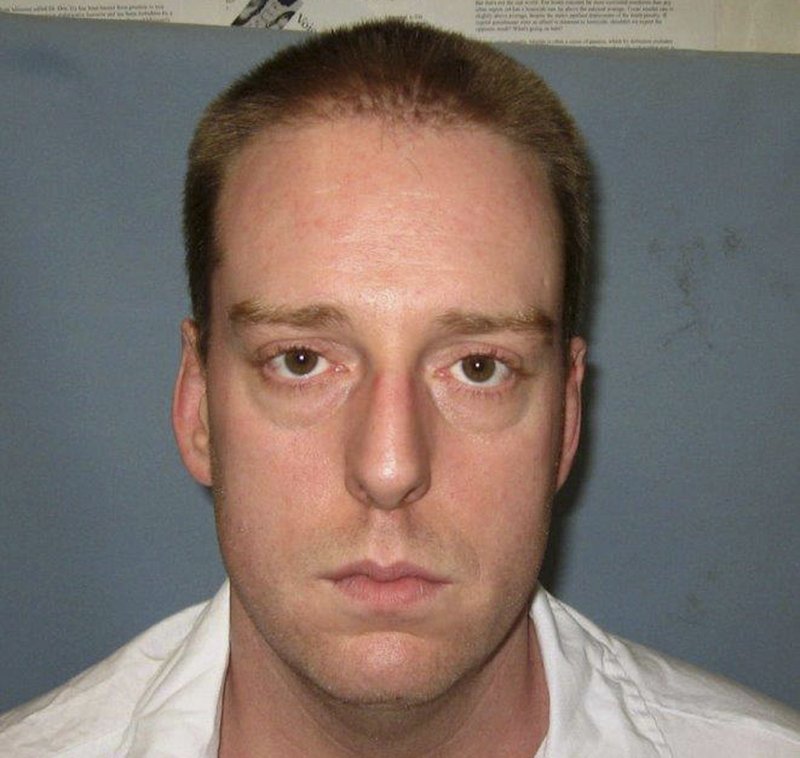ATMORE, Ala. -- Defenders of a condemned inmate in Alabama are calling his execution an "avoidable disaster," but the state prison commissioner says there was no visible evidence that he suffered during his execution by lethal injection Thursday night.
Inmate Ronald Bert Smith Jr. coughed and his upper body repeatedly heaved for the first 13 minutes of the procedure as he was being sedated. Also, his arms appeared to move slightly after two tests were administered to determine consciousness.
Smith's attorneys, who watched the execution, said in a Friday statement that Smith's movements show that he "was not anesthetized at any point during the agonizingly long procedure."
Alabama's Corrections Commissioner Jeff Dunn disputes the assessment that Smith was in pain, saying Alabama properly followed a lethal injection protocol that has been upheld by the courts.
"Early in the execution, Smith, with eyes closed, did cough but at no time during the execution was there observational evidence that he suffered," Dunn's statement said. Dunn said a required autopsy will determine if there were any irregularities.
Smith was sentenced to die for shooting convenience store clerk Casey Wilson in the head in a 1994 robbery. A jury, in a 7-5 vote, recommended a life sentence, but a judge imposed the death penalty and likened the slaying of the pistol-whipped clerk to an execution-style killing.
Smith's final movements during the lethal injection are expected to be fiercely debated as Alabama resumes executions after years of litigation and a drug shortage created by campaigns against the death penalty. Inmate advocates argue that Alabama's process is too flawed and secretive, raising the risk of botched executions.
"No autopsy can measure the extent of Ron Smith's suffering as he died. We are profoundly disappointed that the state and courts failed to intervene at any stage and take steps to prevent this avoidable disaster. We will continue our own efforts to make sure this suffering does not occur again," said Smith's lawyers with the Alabama Federal Defenders Program.
This was Alabama's second execution using midazolam to render an inmate unconscious before injections of rocuronium bromide and potassium chloride are given to stop the lungs and heart.
The U.S. Supreme Court ruled 5-4 last year that midazolam wasn't proved to violate the Eighth Amendment's prohibition on cruel and unusual punishment. Inmates have continued to challenge its use, saying it is a sedative, not an anesthetic, and cannot reliably render a person unconscious.
Soon after Smith's execution began, he clenched his fists and raised his head.
Unlike Alabama's first midazolam execution, the state performed a second consciousness check on Smith as he continued to cough and heave.
A corrections officer standing in the execution chamber gave Smith two consciousness checks, which involved stroking the area around his eyes, saying his name and pinching his left arm. If the inmate does not respond, the warden, from the control room, administers the final two drugs, Dunn said.
The first check was given at 10:37 p.m. Smith's left arm moved slightly after the pinch. A second check was performed 10 minutes later. Smith did not immediately respond, but shortly afterward, his right hand and lower arm appeared to lift slightly.
Smith's attorneys noted the movement to each other as they watched the execution. Dunn, who also watched the execution, said he did not see movement.
Smith's lawyers believe that the state gave him an additional dose of midazolam after he responded to the first consciousness test, but Dunn declined to say if a second dose was used, saying the department won't discuss specifics of the protocol.
"I think we saw last night what we, unfortunately, have seen so many times before, which is that midazolam, which was never intended to be used this way, is not effective and can't be used this way," said Cassandra Stubbs, who directs the capital punishment project of the American Civil Liberties Union.
Arizona, Ohio and Florida also have used midazolam. Mississippi and Arkansas, which have not executed an inmate in several years, have also announced plans to use the drug.
Critics have pointed to problems with executions in three other states that use midazolam. In Ohio, inmate Dennis McGuire repeatedly gasped and snorted for more than 26 minutes while being put to death. In Arizona, Joseph Rudolph Wood gasped and snorted for more than 90 minutes after his execution began.
Alabama executed Christopher Eugene Brooks in January for the 1993 rape and beating death of a woman. Brooks did not display the type of movements that Smith did, according to media witnesses.
Smith's execution -- as measured from the time the curtains open from the viewing room to the time he was pronounced dead -- lasted about 8 minutes longer than Brooks' did.
A Section on 12/11/2016
